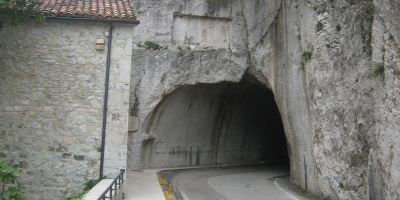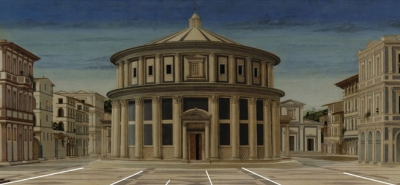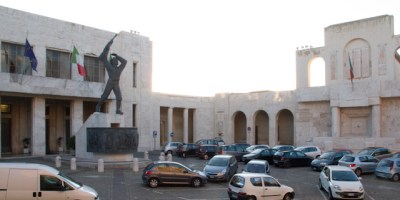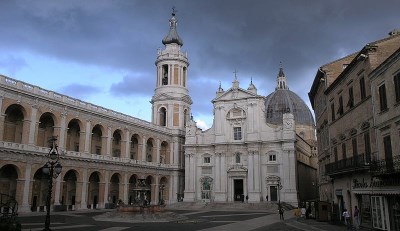|
Welcome to the spring edition of the Marche Voyager newsletter. We've had a very low-key Easter, as everywhere else in Italy, but hope is in the air again. Vaccine rollout, given the universal shortgage of raw materials across the globe, is slow but steady. In the meantime, we thought we’d once again offer you some pieces from our past 60 issues of the newsletter to brighten up your day – buona lettura wherever you are!

A fishy story (Spring 2008)
One of the more exotic creatures you'll frequently find in any Marche pescheria, or fish shop, are cannocchie (or pannocchie). This curious crustacean - known in English as a "mantis shrimp" - is the marine equivalent of the praying mantis and goes under the linnaean name of Squilla mantis. They are a speciality of the Adriatic and are usually sold still alive and, literally, kicking; the two large, distinctive "eyes" are marks on their tails probably evolved to warn off predators.
As well as being an essential ingredient in fish soup and brodetto, the Marche fish stew, they are delicious eaten cold after being very quickly poached for a few minutes in a small amount of water; once cooled, cut the top of the carapace with a pair of scissors from end to end, extract the flesh in one piece and serve dressed with good olive oil and lemon.
A Dish for a General? (Spring 2009)
One of the region's best known pasta dishes is Vincisgrassi, a local variation of baked lasagna with a ragù, or meat sauce, that traditionally includes chicken giblets and sweetbreads or bone marrow. Some cooks maintain that the sheets of pasta should be made with a little added vino cotto or Marsala. It is particularly prepared in the central and southern areas of Le Marche.
Many will tell you that the dish was named by a cook from Macerata in honour of Alfred von Windisch-Graetz, an Austrian general fighting against Napoleon in 1799 during the siege of Ancona. However, a marchigiano cookery book of 1781 features a similar recipe for a type of lasagna called Princisgrass, said to be so named as it was rich enough to be fit for a prince.
Factoid #12 (Spring 2009)
The five most common surnames in Le Marche are Rossi, Mancini, Ricci, Marinelli, and Moretti
Holy Week (Spring 2010)
A number of towns across Italy mark the week before Easter - particularly Good Friday - with full-scale costumed re-enactments of the biblical Passion of Christ. The most striking of these passioni viventi in Le Marche include La Turba at Cantiano (PU), the La Morte del Giusto at Villa Musone, Loreto (AN), and the Rievocazione storica della Passione di Cristo at Mogliano (MC). Many other towns organize atmospheric processions on Good Friday often featuring hooded penitenti, or penitents, walking barefoot through the streets.
Factoid #16 (Spring 2010)
The town of "Ruffano" in Daphne Du Maurier's entertaining novel The Flight of the Falcon (1965) is based on Urbino; the climax of the book takes place on the twin towers of the Ducal Palace.
Fig in pig's clothing (Summer 2010)
One of the region's oddest "salami" is lonza di fico or salame di fico, actually not a salami but a mixture of minced dried figs, almonds, walnuts, mistrà, or aniseed liqueur, wrapped in a fig leaf and shaped to resemble a salami.
This Marche speciality, boasting its own Slow Food "presidium", or official mark of recognition, is best served with some of the region's excellent mature pecorino ewe's milk cheese. It's made in Ancona province but on sale throughout the region.
On the road to ruins (Summer 2010)
Le Marche has some 34 important archeological sites, including outstanding ruins from Ancient Roman times. This summer the remains of the Roman theatre in Ascoli Piceno is set to be re-opened to the public after a recent facelift.
The imposing theatre, first unearthed in 1932, stands on Colle dell'Annunziata in via Francesco Ricci and has been dated to the end of the 1st Century BC - if you can't visit it in person check it out on Google Street View.

Other Roman sites worth visiting in the region include the Roman remains at Falerone and Urbs Salvia - both host to Classical theatre festivals in high summer - the Roman triumphal arches at Fano and Ancona, and the Roman tunnel and cutting through the Furlo Gorge (see photo above).
Know your onions (Summer 2010)
One of Le Marche's more curious folk traditions is the use of onions at Urbania in Pesaro & Urbino province to foretell the coming year's weather. On the night of 24 January twelve onion sections - one for each month - are sprinkled with salt and left outside; in the morning the way the salt has dissolved is examined and the weather forecast made.
The the secret of reading the onions of Urbino is said to date back to Medieval times and is currently guarded by Signora Emanuela Forlini, a local teacher who inherited the skill from her father and grandfather.
Fair squares #6 (Spring 2012)
This month's image of one of the region's piazze, or town squares, features one that only exists in two dimensions - it's the celebrated painting in Urbino's Palazzo Ducale known as La città ideale, or The Ideal City. Nobody really knows who painted this enigmatic image and its two companion paintings that are nowadays on display in Baltimore and Berlin.

Little weeds (Spring 2013)
Now is the season to comb the fields and woodland for erbe del campo, the various wild herbs that still play a part in the dieta marchigiana.
Weeds such as the common dandelion and the field poppy are eaten when young either raw in salads as part of a misticanza, or boiled and quickly tossed in good olive oil with a clove of garlic and a squeeze of lemon juice.
One of the most sought after of these wild plants is Silene vulgaris, the common weed bladder campion. In the Marche it is variously known as striti, stridi, or stringoli and the young shoots are lightly cooked and used in a frittata, or omelette, or fried with onions and some ham for dressing pasta.
A useful blog on wild herbs in the Marche (in Italian and English)
Barocci redivivus (Spring 2013)
Federico Barocci was one of the most talented artists of late 16th century Italy but has remained little known outside of his native Marche. However, a major new show of his work at London's National Gallery looks set to bring him to the wider public he deserves.
He was born sometime around 1533 in Urbino where he remained for most of his life until his death in 1612. Fascinated by the human form, he fused charm and compositional harmony with an unparalleled sensitivity to colour.
The Barocci: Brilliance and Grace exhibition runs until 19 May 2013, and has been described by the Daily Telegraph's art critic Richard Dorment as "staggeringly ambitious and heartbreakingly beautiful".
British National Gallery Barocci exhibition website
Fair squares #10 (Spring 2013)
This month's image of one of the region's piazze, or town squares, features the unusual Piazza Corridoni in Corridonia in the southern Marche. The name of the town was changed in 1931 by Benito Mussolini from Pausula in honour of Filippo Corridoni, a war hero and union activist who died in the 1st World War in 1915. The town's main square was completely remodelled in travertine and is dominated by a striking statue of Corridoni by Oddo Aliventi (1936).

photo: huntley hedworth
Factoid #32 (Spring 2014)
Lucrezia Borgia's first marriage - arranged by her father when she was 13 - was to Giovanni Sforza, ruler of Pesaro in the northern Marche.
The other ducal palace... (Spring 2015)
It may not be quite up there with Urbino's palazzo ducale, but the ducal palace at nearby Urbania boasts an appealing museum and interesting renaissance architecture. Urbania itself is an attractive small town with an abundance of good restaurants, and a macabre collection of mummies in the Chiesa dei Morti.
Fair squares #24 (Spring 2017)
This spring's picture of a Marche piazza is the Piazza della Madonna in Loreto, the elegant set-piece square with a delicate baroque fountain that fronts the celebrated basilica dedicated to Our Lady of Loreto. To the left are the arcades of the 16thC Palazzo Apostolico.

peter geymayer/wikipedia
Bleat news (Spring 2018)
The ewes' milk pecorino cheese made across the region - often by Sardinian shepherds whose families have for generations populated the uplands - is at its freshest now as the sheep crop the rich spring pastures. The new cheese is perhaps best eaten with young raw broad beans or fave now in season as a simple antipasto. Incidentally, sheep's milk contains roughly twice as much calcium as cow's and goat's milk.
Infobyte #48 (Spring 2018)
The splendidly-sited monastery of Fonte Avellana, on the eastern flanks of Monte Catria in the northern Marche, was celebrated by Dante in the 21st Canto of Paradiso.
Licking the competition (Spring 2019)
Ice cream in Italy is a two-billion Euro business which employs some 40,000 people. The prestigious Italian food and wine magazine Gambero Rosso produces an annual Gelaterie d'Italia guide and awards the finest ice cream producers a tre coni, or "three cones" rating, one of which has been given this year to a gelateria in the Marche: Paolo Brunelli at Senigallia.
This newsletter is only sent to people who have personally subscribed to it through the Marche Voyager web site. If you do not wish to receive further issues please unsubscribe here. Alternatively, please e-mail us
giving the e-mail address to which this newsletter was sent and "unsubscribe" in the message subject. You are subscribed at [EMAIL]
.
If you have problems reading this HTML newsletter you can see it on the web
here.
We appreciate feedback - any comments, suggestions, criticism or praise gladly received; E-mail us here.
© le-marche.com
| 